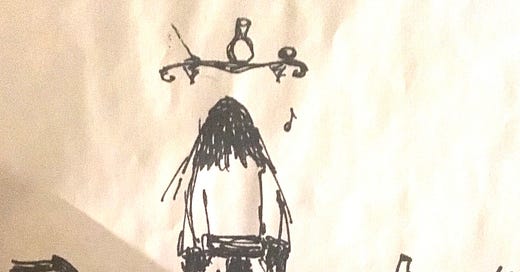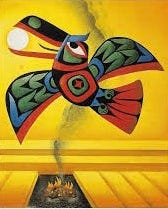In the beginning, the world was a dark blur.
Raven was there from the beginning. He flew along, high up in the dark sky, and had a hard time seeing what was below. He was cold, too, and was starting to get sick of bumping into things in his flight. Suddenly, he heard whimpering, and as he flew lower, he saw that a group of new things, humans, were huddled blindly together, shivering in the cold. Raven felt sorry for the poor things, and set out on a search.
He’d heard rumors that the Sky God had been keeping a great treasure all to himself. So Raven set out to the Sky God’s house to see what it was, and if it could help. But he had to be careful—the Sky God was selfish and he was powerful.
Raven arrived at the Sky God’s beautiful house, and he saw immediately what the treasure was, and knew he had to take it, to give it to the world, and those poor humans. The treasure was a ball of warm yellow light, that glowed and gave off welcome heat. Raven watched the Sky God toss it in his hands like a juggling ball, and then hide it away in a secure box. Raven waited in a nearby pine tree, waiting for his chance.
When the Sky God’s daughter came out to gather water, Raven knew what he had to do. He transformed himself into a pine needle, and when the Sky God’s Daughter filled a cup of water to refresh herself, Raven-needle fell into the cup, and was swallowed.
Nine months later, she gave birth to a baby boy, with a suspiciously long beak-like nose, pine-needle green eyes, and a raucous caw-ing laugh. The Sky God adored his grandson, and gave him anything he wished.
One day, toddler-Raven pointed at the box where the light was kept. He pointed and he cried and cried. “He wants the box,” said his mother. “Give it to him,” said the Sky God. When the box was placed on the floor next to Raven, he cried and cried even louder, croaking and caw-ing in his cries. “He wants what’s in the box,” said his mother. “There can be no harm. Open the box, and give it to him,” said the Sky God.
The Daughter opened the box, and wide shining beams of light poured out. “Gah! Gah!” cooed Raven. The Sky God took out the bright ball of yellow light, and handed it to Raven. “Gah! Gah!” he said. Then, “Caw! Caw!” as he transformed back into his fully bird-Raven self, snatched the light up in his beak, and flew away.
When he was far into the sky, Raven tossed the Sun up, where it hovered, spilling light down onto the world, and warming the whole world with its beams.
Here’s a Musing about this story, and the so very many others with similar themes: humans weren’t meant to have fire, or the sun—it’s a precious commodity, in all these variations. And so, a trickster figure must steal it and give it to them. Prometheus, Raven... This important theft happens across several cultures (and also retold in modern versions of old stories, like the flaming sword gift in Good Omens, for example).
But what’s a tengu, and what do ravens and the sun have to do with them?
Well, the tengu taught the ninja everything they know.
Tengu? I hardly know you…
There are two types of Japanese mountain-goblin called tengu: the hanataka, which are red-faced long-nosed oni types that cause lots of violent mischief not unlike the redcaps in Celtic folklore. But I’m not as interested in them as I am in the other kind of tengu:
The karasu-tengu (karasu being Japanese for ‘raven’) are the ones that interest me. They are humanoid but with wings and bird-heads—raven heads, to be more precise. I picture them as kind of a mid-transformation were-raven? Anyway, these guys were extremely clever tricksters that were also highly skilled martial artists. The karasu-tengu were said to be the senseis who taught the first ninja all about the martial arts, especially sword fighting.
There’s an odd connection between the Sun and ninjas, too. I say ‘odd’ because for a group of mythical assassins that are so tied up in darkness imagery (I mean, one synonym of ninja is shinobi, which basically means shadow-warrior), they’re said to be fundamentally connected to Amaterasu, the goddess of the Sun. She’s a major deity in classical Japanese mythology and considered the patron god of the ninja. Why?
I’m pretty sure it’s because of the trick that the other gods used to get Amaterasu to come out of the cave that she’d hid herself in. See? Again—the Sun is hidden away by a god and has to be stolen or otherwise brought back into the world by a trick. The trick in this case was a mirror that they had strategically placed outside the cave where she was hiding. They enacted a ruse that made Amaterasu jealous/curious enough that she opened the cave door just a little, enough that she was struck by her bright reflection in the mirror, and they were able to snatch her out. The ninja of old would use mirror-blinding just like this, as well as other techniques using mirrors to confuse, so they feel related to or descended from the trickster gods that tricked the Sun.
How are tengu connected to Amaterasu? I don’t think they are, except by one remove, since they taught the ninjas their techniques and the ninjas were inspired by what happened to her. Also the connection between ravens and the Sun: there’s another one in Japanese mythology, in Shinto lore in fact, this one with three legs.
I’ve read different versions of who sent Yatagarasu (garasu = karasu) to the world to be a divine interlocutor between the gods and mankind, but definitely in one of these stories he was sent by Amaterasu. His 3 legs symbolize the three pillars of existence: gods, earth, and man. And he’s often shown perched in front of a sun disk.
I studied classical Japanese martial arts, descended from the Genbukan and Bujinkan legacies, both of which had much of their teachings based in old school ninja arts. I studied under my now-ex-husband for about a decade, and with another local dojo for several years after that, finally concluding my active formal study of those arts in 2010. But back before my then-husband’s school was active in Boulder, he owned and operated another dojo that taught those same arts. Their logo was designed by him, and it depicted the 3-legged raven in front of a sun-disk of gold.
But he’s a 3-legged raven, not a tengu, so I DIGRESS…

Naropa? I hardly know her…
I applied for the MFA program in Writing and Poetics at Naropa University (of Boulder Colorado), in a sequence of applications not unlike the fabled samurai trial of a n00b being rejected and yet then persistent enough to finally be allowed to join. I applied twice to the Prose side of things, only to be accepted the third time into the Poetry track. Third time’s the charm, I guess. Two intensive years later, I graduated with an MFA in Prose. Long story, and still a mysterious, but my point is: I wrote a *lot* of poetry in grad school.
I’d always been obsessed with ravens (& crows a little), and so through my whole grad school experience (1999-2001), I’d sketch them whenever I saw them, which was often. And I infused lots of raven lore from all over the world along with my real-life observations into my grad school work. My advisor was the late great poet Anselm Hollo—his surname being Finnish for ‘raven.’ I found that to be fortuitous, but he didn’t like me very much—called my work ‘determinedly derivative.’ so. Eh. Fuck that guy. Kinda? Also rest in peace, or whatever. Nomine patri et spiritus sancti…
My MFA thesis was on The Trickster—I traced trickster figures through myth and poetry and mythopoetics and then ended with Gregory Corso because hey. It was Naropa. (Google it, kids.) But. Raven is my fave(n) out of all the Tricksters, and it’s certainly my favorite animal.
And so all this work on mythos and poetry and research was happening at the same time as my intensive training in Japanese martial arts from apparent ninja legacies. So it may have been something in the pre-algorithm psychic cycle of seeing everything you’ve mentioned once you’re interested in, all around you, but.
The figure of the skilled, clever, mountain-dwelling tengu feels like a bridge between my literary, theatrical, and martial arts practices, and I can’t exactly explain why. My love of the Trickster & Shakespeare’s fools is vaguely one of my poetic interests (and certainly one of my main theatrical ones), and jesters do have that same tricky/intelligent characteristic. The martial arts that are complex, tricky, unfair, using acrobatics to evade, and rife with symbolism and near-magic is part of that, too, let alone the lore that the tengu were the ones that invented that whole nonsense. And. Since ravens are my favorite animal, I’ve got the cleverness of the bird melded with the expertise of the art form (whatever art form it might be) = tengu. Also? If I were a supernatural creature, what with my background and brainiac tendencies and humor? I’d be a tengu.
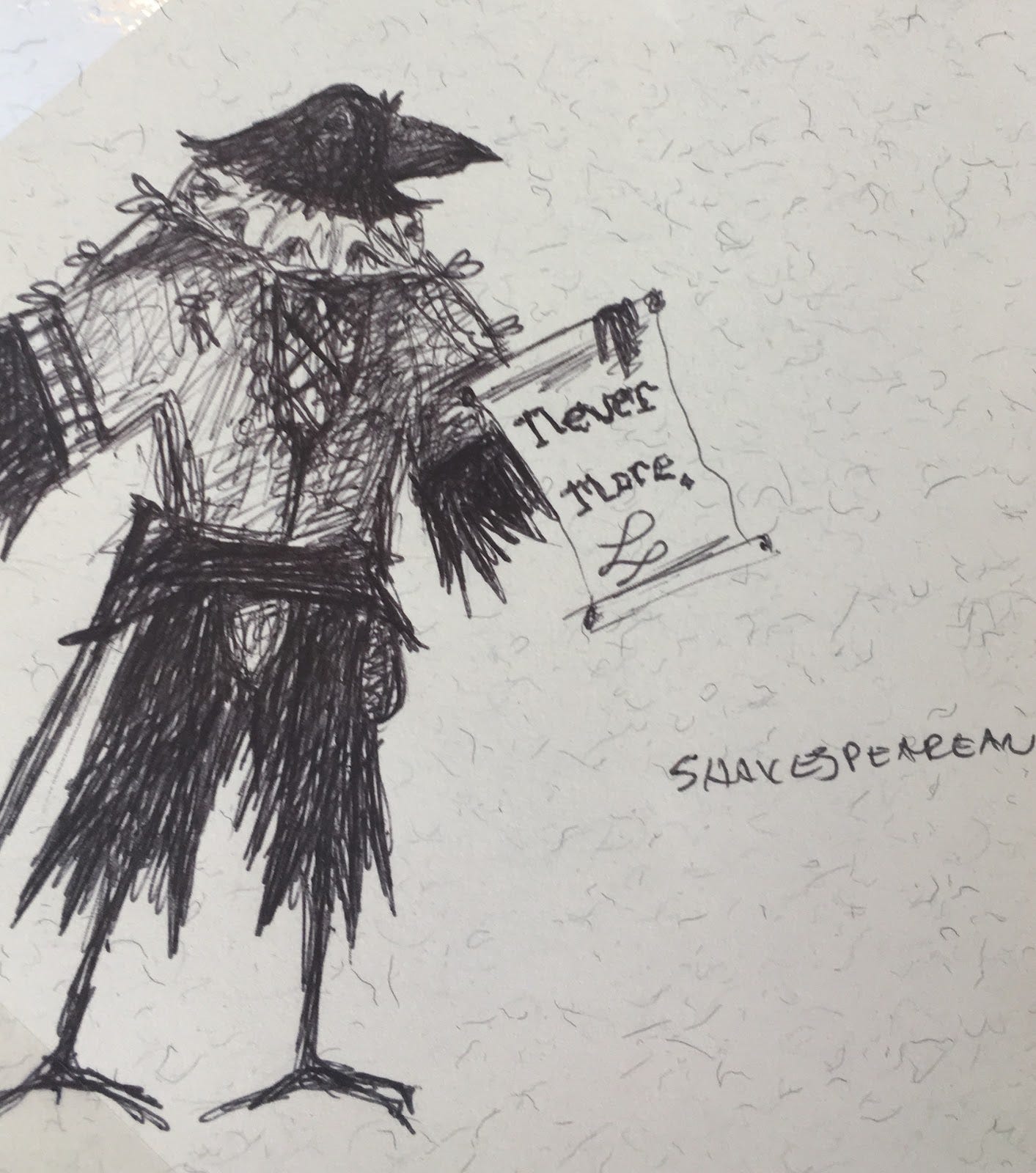
Back to the Birdhouse
Remember in this piece: It Takes a Village Coffee Shop, when I talked about The Birdhouse and its role as a safe haven for my newly divorced self? Here’s a reminder:
I named my new apartment The Birdhouse because: a) it was on the third floor, with no elevator, so you had to climb three flights of old smoothened wooden stairs to get there; b) it had (fake) wood floors and a vaulted ceiling, so it was like a little wood box style birdhouse that kids might make in shop class; c) my nickname at the time was Bird or Jennybird, and it was my house; d) there was a very loud and friendly unkindness of huge ravens* that often roosted either on its roof or the roof across the street—there was a cable protruding from right near my westernmost window, and they’d sometimes perch there and yell at me right through that window. And they’d socialize and have big luxurious meals out of the dumpsters in the parking lot below.
Ravens are my favorite animal, so I did feel like I was being kind of, I dunno, protected by good spirits?
…
*Of all the panoply of weird names for groups of animals, “an unkindness of ravens” is one of the most bizarre, don’t you think?
When I first moved in, and the ex deposited the last load of my belongings to it, hovering with watering eyes at the threshold before leaving forevermore, I had a hippie-dippie friend from the burlesque troupe I was in come over and do a full witchy assessment and cleansing of the place. She was one of those crunchy white girls with the blonde dreads that still didn’t understand how to do ‘natural’ deodorant correctly, and who resonated with the Viking version of ravens herself. Her ceremony was a housewarming gift to me, and hey, even if I’m not of whatever religion or practice, I’m never one to turn down a blessing.
She came in and did her psychic symbolic dowsing thing and ascertained that the place had really good energy. She wasn’t wrong—the moment I came in to look at it as a possible renter, I got a fantastic vibe from the place. She’d gleaned that the previous resident was a woman and a student in some kind of sciences, and she too noticed the proliferation of ravens around the place, naming them (as I had already done) as my protectors. She burned incense in all the corners, instructed me as to which corners of which windows which of my cool rocks I should place, and then told me that there was one thing missing in the Birdhouse. She told me I needed to have more sex in it. With someone other than myself, she hastened to add. Nice work if you can get it. And my partner did.
Whenever I’d feel too alone in The Birdhouse, 4 or 5 ravens would gather around, forage at the dumpster, and sit on the big comcast wire that erupted a couple inches to the side of my middle South-facing window, and yell at me. This would prompt me to rise up out of my funk, crack one of my other windows, and blast Eluveitie loud as the wee Bluetooth speaker would allow. They were making sure I was okay.
Because of them (amid many other things), I was.
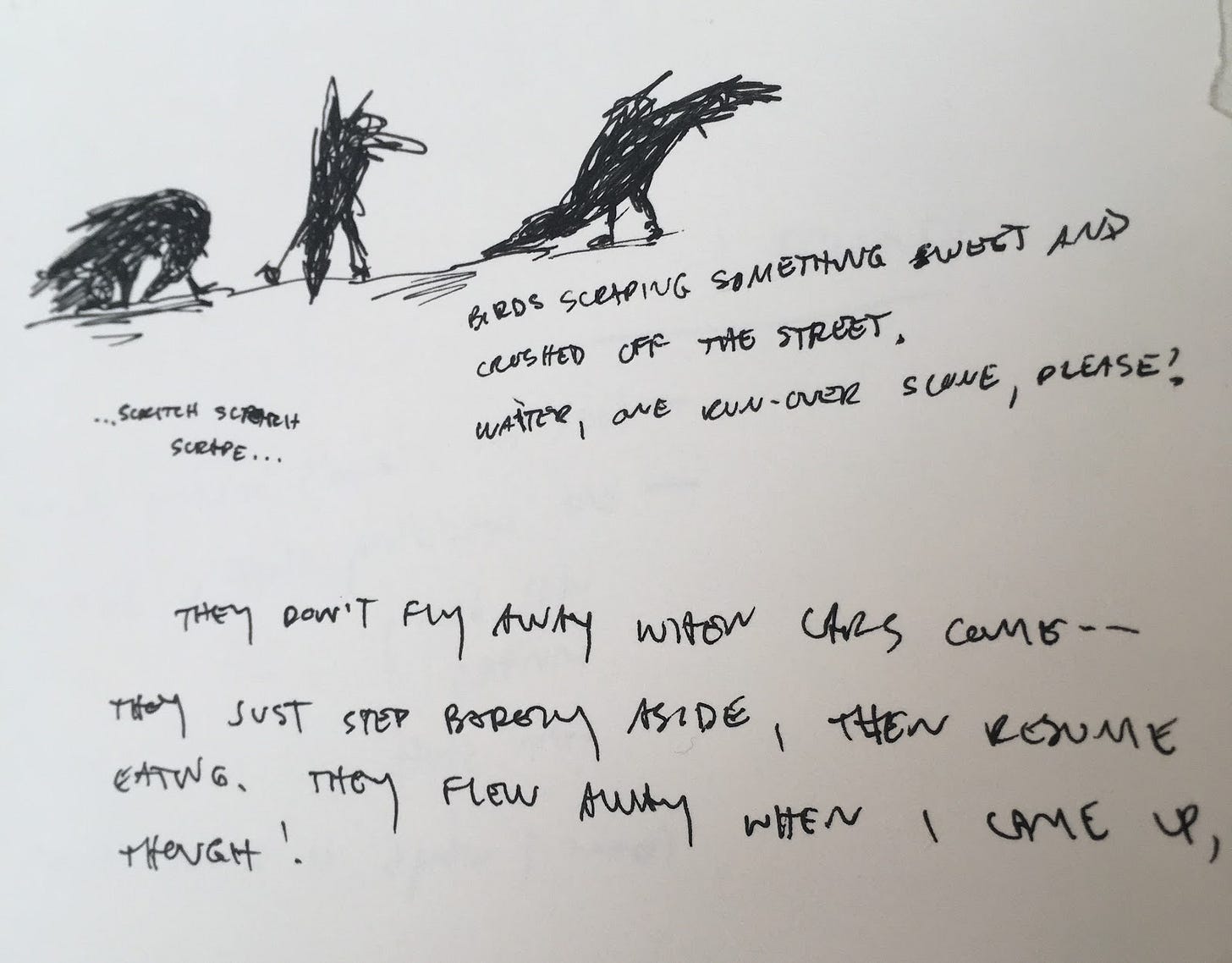
Transcription (L to R):
…scritch scratch scrape…
Birds scraping something sweet and crushed off the street. Waiter, one run-over scone, please?
They don’t fly away when cars come—they just step briefly aside, then resume eating. They flew away when I came up, though!
Clever? I hardly know her…
Ravens are one of the very cleverest animals in existence, and are certainly one of the very most adaptable: they live on every continent where beings can live, and within those, they’re in every environment possible—they’re totally cool in urban situations, as well as rural. As well as wilderness. Their intelligence means they’re excellent problem solvers, which explains that. They live everywhere and do their best, just like humans do.
The ravens I always watched when at Naropa and ninjutsu followed me from the abusive martial arts scenario of my husband’s dojo into my own private space that cultivated my own personal disciplines (including the Japanese arts I’d begun). Actually, knowing how corvids are so excellent at recognizing faces, maybe this is literally true. Hard to say. But I appreciated their presence in my life, and really did truly feel like they were my friends, or at least a friendly band of protectors.
Now? I don’t see many ravens or even crows around my current abode, but I’m not forsaken—there’s a very clever band of magpies that nest nearby, and they sass and salute me all the time.
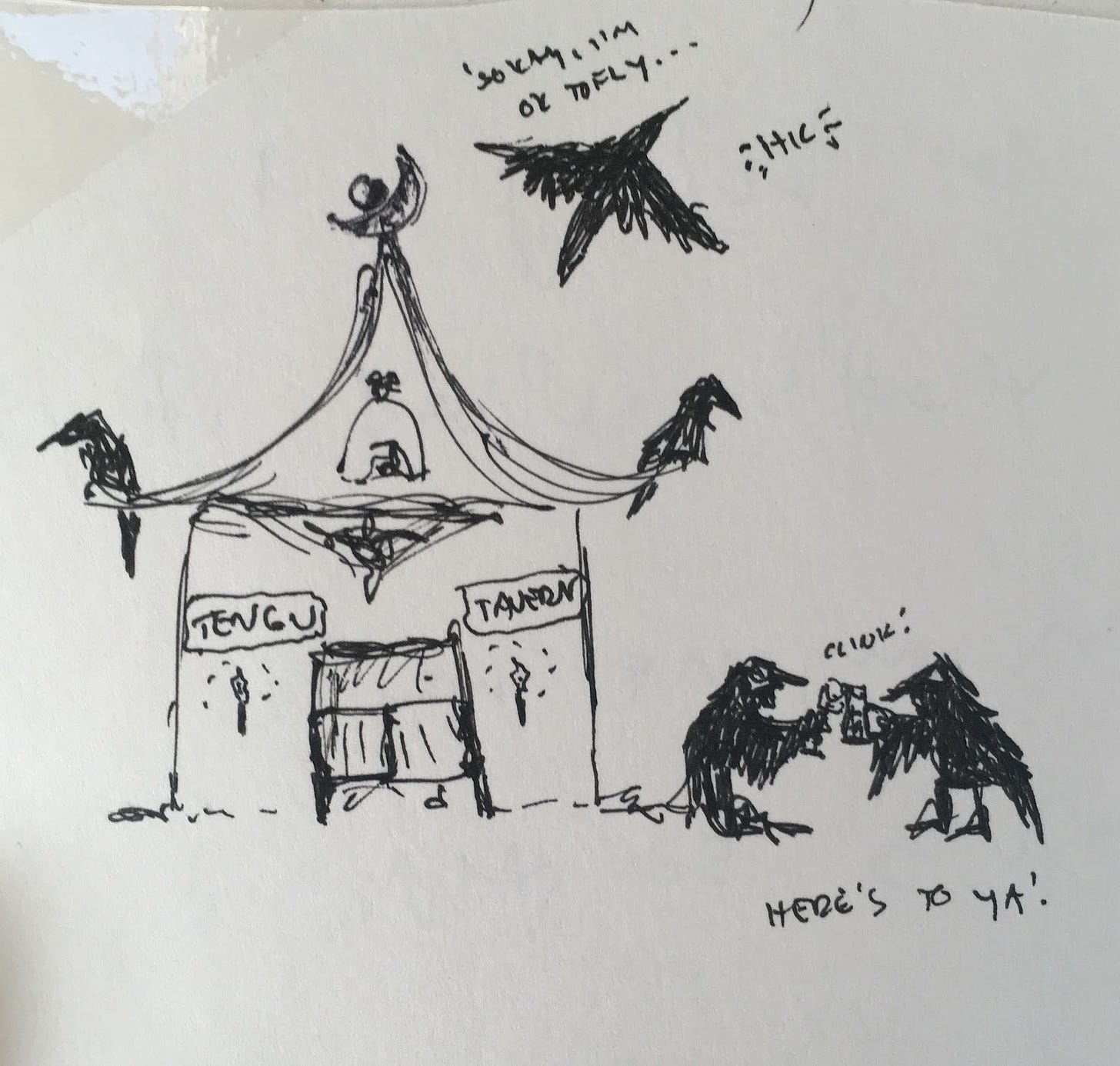
Transcript (top to bottom):
’Sokay, I’m okay to fly… <hic>
TENGU TAVERN
<clink!>
Here’s to ya!
Omen? I hardly know him…
It’s funny: you’ve got Raven as the bringer of light and life in many indigenous cultures and Eastern mythologies, but in several European ones, it’s an omen of death (but also sometimes wisdom). Maybe there’s something to that connection of death and knowledge in these old stories—like when Adam and Eve ate from the tree of knowledge and then were cast out and got all mortal and stuff? Hm…
You’ve got the Morrigán from Celtic myth, who is associated with ravens and with death, especially battlefield death. You find her on your field of war, and you know your time is about up. Another Northern located warrior culture, the Norse/Vikings, have a Zeus-like elder god of gods (but he’s far more of a wise man and a trickster than Zeus, right?) who gave his eye in the name of knowledge, and hanged himself for …what was it, 7 days? 9? in order to gain wisdom of the ages. He’s the All-Father, Odin himself (I think of him every Wodensday when it’s time for a half-off bottle and a writing session at my ‘local’, where I salute both him and Dionysus). Hugin & Muninn are his two ravens, whose names mean Thought, and Memory, and they fly into the world each day, and each evening bring back all the stories and the intel to Odin on his throne, caw-ing into each of his ears in turn.
Wasn’t it a raven that Noah first sent out from the Ark to look for land, before the dove finally found it? Jeez I’m such a bad Xtian, mea culpa. But like: why Raven first though? Any Biblical scholars out there want to weigh in on ravens in the Bible? One of them fed Elijah too, right? Was that one a tengu? Did it teach him to fight? That makes me think—I was going to tell that fable about the crow and the pitcher, too, but I’m getting way too far in the weeds here with my corvid lore (lorvid core?); I should move on.
Did you know that some versions of the Raven-stealing-the-sun story burn Raven black as a punishment for stealing? He starts out pure white and very vain before, then he does the sacrificial task of the theft of light, and is burned black as soot for his pains. It’s cool—I always preferred wearing black anyway. I didn’t even get married in white.
CONCLUSIO(me)N
Intelligence is both feared and honored. Anyone who’s a trickster has to have high intelligence. Ravens are some of the most adaptable, smart creatures on earth. Man-ravens, or tengu, are so brilliant they taught the ninja how to fight.
Thought, Memory, Light. Let the sunshine in.

